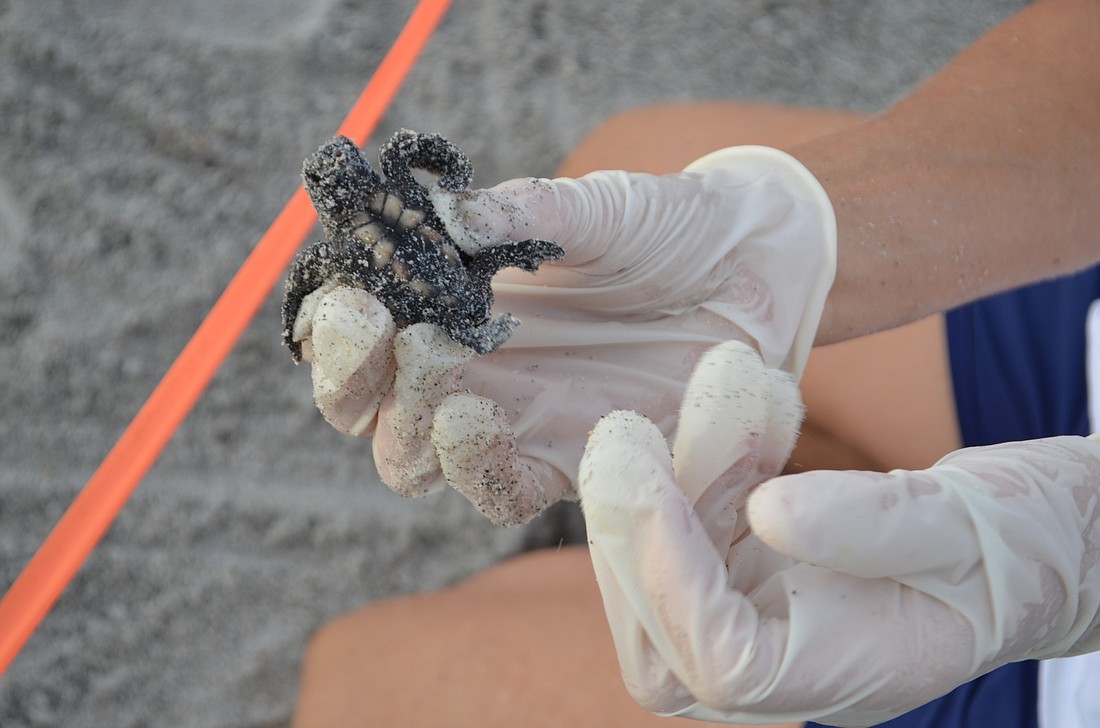- November 5, 2025
-
-
Loading

The sun is rising behind the beaches of Longboat Key. Like other Key Turtle Watch volunteers elsewhere on the beach, Cyndi Seamon and Susan Gaillard are walking a stretch of the sand on this Monday morning, marking and monitoring nests when a man hurries over to them carrying a red bucket.
In his bucket, the employee of a nearby condo community carries two turtle hatchlings. He tells the women he found the turtles crawling toward Gulf of Mexico Drive.
Seamon and Gaillard inform the man that there must have been a source of light on his property that disoriented the turtles. Hatchlings by instinct are drawn to reflected moonlight on the gulf’s surface. The man was taken aback. To his knowledge, he said his property met all of the town’s regulations.
There is no other explanation for the turtles’ behavior, the volunteers said before finding a few more wayward hatchlings nearby.
Seamon said the man’s misunderstanding of the town’s turtle nesting laws is a common problem among property owners, residents and visitors on the Key.
“Some of them think they’re doing the right thing,” Seamon said. “They just haven’t researched it.”
In 2016, the town revised its turtle nesting ordinance, implementing stricter standards for light and beach obstructions. Enforcement of the new rules began this season, but the focus is on education and compliance.
Rules for turtle nesting season, which began on May 1 and ends Oct. 31, include:
Six months before the season began, town officials started working to educate Longboaters about the changes to the ordinance. These efforts included visiting every condo community along the beach, delivering educational brochures and hosting an informational workshop.
Still, turtle disorientations are common, Seamon said. There have also been three reported incidents of adult turtles becoming entangled in beach furniture.
In July, Key police stepped up efforts to address violations of the turtle-nesting ordinance. Police Chief Pete Cumming said the department has trained Community Service Specialist Ivan Zunz to walk the beach at night, making note of possible violations to report to Code Enforcement Officer Chris Elbon.
As of July 30, Zunz has conducted six nighttime inspections, adding to Elbon’s 17. A total of 244 emailed reports of potential violations have been received by the town. All of them resulted in contact between the town and property owners or managers.
After nesting season ends this fall, Town Manager Dave Bullock said town staff will meet with Mote Marine Laboratory and Aquarium officials, Turtle Watch volunteers and others to determine how to improve the town’s ordinance.
“We’ll get through this season and see what everyone thinks,” Bullock said.
Seamon said the ordinance “might need to be tweaked a little bit.” She asserted that dragging beach furniture to the dune line at night is not enough to protect the sea turtles. The Turtle Watch volunteer suggests that the town include a requirement that beach furniture be stacked at night.
Seamon would also like to see the town identify potential enforcement problems and focus on remedying them. Also, Seamon said raccoons, as well as crows, seem to prey on turtle nests more this season. “I don’t know what these raccoons eat when it’s not turtle season,” Seamon said.
Efforts to address this issue will be part of the post-season discussions, Bullock said.
“I’d like to think when the Colony is developed, we’ll have fewer raccoons,” Bullock said.
Enforcing the rules
A violation does not always result in formal action. Here are the steps the town typically takes:
Courtesy notice: If the violator has no prior warnings, the code enforcement officer will tell property owner or manager that there is an issue.
Notice of violation: If the violator ignores the problem, a formal notice will spell out what needs attention and a deadline.
Violation: If the problem remains uncorrected, the violator will be informed in writing to appear before the Code Enforcement Board. Fines are possible.
Publix: Helping to Educate
Since June, Publix on Longboat Key has had a display, developed by the Sea Turtle Conservancy, set up at the entrance of the store to educate residents and visitors about sea turtle nesting season. The display includes a video, an example of a turtle-friendly light bulb enclosed in a fixture and pamphlets.
"The fixtures are a great tool for preserving the population,” said Publix spokesman Brian West. “ We're so thankful to be able to support such a unique effort."
Setting an Example
Assistant Town Manager Mike Hein points to Ocean Properties, the company that owns and operates the Resort at Longboat Key Club and Zota, as an example to follow.
Jeff Mayers, general manager of the Resort at Longboat Key Club, said he and his staff work closely with Mote Marine and the town to determine guidelines to ensure the resort’s compliance with turtle nesting rules. Along with educating guests upon their arrival with informational brochures, the resort’s security staff patrols the property’s beach nightly. If a light in one of the resort’s rooms is visible, “we’ll contact the guests and make them aware,” Mayers said.
Sandra Rios, director of marketing and communications for Ocean Properties, added that Zota, which opened in June, was built with turtle-friendly features, including blackout drapes and proper lighting.
By the numbers
Beach obstruction cases
41 pieces of furniture tagged in violation
1 courtesy notice
2 written cases
1 case of furniture impoundment
Lighting violations
13 cases opened
10 cases closed with compliance
3 cases active (Officers are working with property owners)
Source: Town of Longboat Key
Raccoon cases
The following is a breakdown of documented raccoon depredations on Longboat Key from 2015-2017.
2015: 91
2016: 361
2017: 179 (to date)
Source: Mote Marine
For tips from Mote Marine Laboratory, including what to do if you encounter sea turtle hatchlings, click here.